First Etui
The First Etui (ファーストエツイ) is a Japanese 6.5×9cm folding plate camera, advertised by First Camera Works or Minagawa Shōten from 1934 to 1936 and probably sold until the war.[1] It was certainly made by Kuribayashi.[2]
Contents
Description of the body
The First Etui is a copy of the Patent Etui, a German camera made by KW. The metal body is very thin when folded, with a bulging folding bed: the total thickness is only 3.8cm.[3] The name First Etui is inscribed on a nameplate riveted inside the body.
There is a swivelling brilliant finder attached to the front standard. There is also a folding frame finder made of two parts: a wireframe attached to the lens standard and a simple pin articulated to the body. There is a handle on top of the body and a folding bed release at the top right (as seen by a photographer holding the camera vertically).
Focusing is done by a small wheel on the right of the folding bed, with a focusing scale on the left. It seems that some limited vertical movement is available, and a spirit level is attached to the right of the brilliant finder.
Evolution in the advertisements
In the advertisement in Asahi Camera April 1935, placed by Hattori Tokei-ten and "First Camera Works", the First Etui appears in a number of versions:[4]
- Tessar f/4.5 lens, S Compur shutter (¥165);
- Trinar f/4.5 lens, S Compur shutter (¥115);
- Xenar f/4.5 lens, Rulex A shutter (¥95);
- Radionar f/4.5 lens, Rulex A shutter (¥80);
- Radionar f/4.5 lens, Rulex B shutter (¥72);
- State f/4.5 lens, Magna shutter (¥60);
- Toko f/6.3 lens, Magna shutter (¥54).
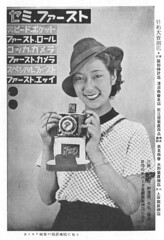
|
| Advertisement for First cameras in the October 1936 supplement to Camera Club, mentioning the First Etui. (Image rights) |
Advertisements in Asahi Camera dated May and July 1935 do not list the Xenar version, and give the price of ¥118 for the Trinar version.[5] In the December 1935 advertisement in the same magazine, the range and prices are unchanged except for a new version with Simlar f/4.5 lens and Seikosha shutter, costing ¥105.[6]
The last known advertisements are dated October 1936.[7] However, the First Etui still appears in the official list of set prices compiled in October 1940 and published in January 1941, in four versions called "First Etui I" (¥43), "First Etui II" (¥52), "First Etui III" (¥76) and "First Etui IV" (¥130), with no further detail.[8]
Actual examples
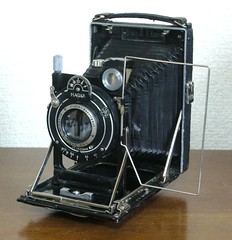 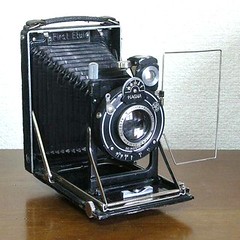 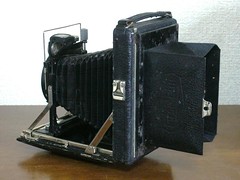
|
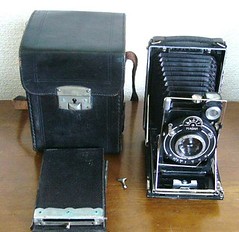 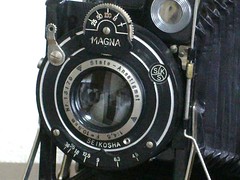 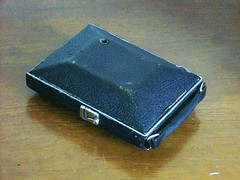
|
| First Etui, State-Anastigmat 10.5cm f/4.5 lens no.13179, Magna shutter (25–100, B, T). image by eBayer Yalluflex (Image rights) |
Only a few examples of the First Etui have been observed so far. They are essentially similar, except for the lens and shutter combination.
The camera pictured above has the State f/4.5 and Magna combination, and is similar to that pictured in Baird and McKeown.[9] The Magna shutter gives 25, 50, 100, B, T speeds selected by a small wheel at the top, and has a simple thread and needle release device. The shutter plate is marked MAGNA in the speed dial, SEIKOSHA at the bottom and has the SKS logo at the top right. The lens has a chrome bezel engraved State–Anastigmat 1:4.5 F=10.5cm Nr.xxxxx, with the triangular logo of Tōkyō Kōgaku on two places. Lens serial numbers are in the 13xxx range.[10]
The example pictured in Sugiyama and in Kamera no ayumi has the Toko f/6.3 and Magna combination.[11] The lens has a black bezel, engraved Toko–Anastigmat 1:6.3 F=10.5cm Nr.1283, again with Tōkyō Kōgaku's logo.
A fourth camera is pictured in this page at Asacame with the Simlar f/4.5 lens and Seikosha combination. The Seikosha shutter (T, B, 1–250) is set by a lever at the top, and tripped by another lever at the bottom. The speed is selected by turning the rim, and there is a self-timer controlled by a small mushroom-like button at the top (as on the contemporary Compur). The shutter plate is marked SEIKOSHA–TOKYO at the top and SEIKOSHA at the bottom, and has a serial number inscribed above the lens. The lens has a black bezel, engraved Simlar 1:4.5 f=10.5cm Tokyo Kogaku Nr.xxxxx, without any logo. The serial number of the lens is in the 23xxx range.
Notes
- ↑ The 1934 release date is given by Baird, pp.16 and 60, Sugiyama, item 1046 and McKeown, p.576. Kokusan kamera no rekishi, p.339, lists advertisements and articles dated 1935 and 1936. The First Etui was still listed in the official price list compiled in October 1940.
- ↑ Baird, pp.16–7 and 60–2; McKeown, p.576. No original document has been found to confirm this.
- ↑ Kamera no ayumi, p.70.
- ↑ Advertisement reproduced in Baird, p.61.
- ↑ May 1935: advertisement reproduced in Baird, p.17 of Kuribayashi-Petri Cameras. July 1935: advertisements reproduced in Kokusan kamera no rekishi, pp.72 and 85.
- ↑ Advertisement reproduced in Kokusan kamera no rekishi, p.85. The aperture of the Simlar lens is not mentioned but it is probably f/4.5.
- ↑ October 1936 supplement to Camera Club, second cover. The last advertisement listed in Kokusan kamera no rekishi, p.339, is in Asahi Camera of the same month.
- ↑ "Kokusan shashinki no kōtei kakaku", type 8, sections 1, 2, 3 and 4B.
- ↑ Example pictured in Baird, pp.60 and 62, and McKeown, p.576.
- ↑ Serial no.13179 on the camera pictured in this article, and 13446 on that pictured in Baird, pp.60 and 62, and McKeown, p.576.
- ↑ Example pictured in Sugiyama, item 1046, and Kamera no ayumi, p.70 (the owner's name is the same in both sources).
Bibliography
- Asahi Camera (アサヒカメラ) editorial staff. Shōwa 10–40nen kōkoku ni miru kokusan kamera no rekishi (昭和10–40年広告にみる国産カメラの歴史, Japanese camera history as seen in advertisements, 1935–1965). Tokyo: Asahi Shinbunsha, 1994. ISBN 4-02-330312-7. Item 195. (See also the advertisement for items 106–7.)
- Baird, John R. Collectors guide to Kuribayashi-Petri Cameras. Grantsburg, WI (USA): Centennial Photo Service, 1991. ISBN 0-931838-16-9. Pp.16–7 and 60–2.
- Camera Club. Saishin shashinki zenshū (最新写真機全集, Compendium of the latest cameras.) Supplement to the October 1936 issue. Advertisement on the second cover.
- Kamera no ayumi. Zen nihon shashin renmei sōritsu 50-shūnen kinen (カメラのあゆみ・全日本写真連盟創立五〇周年記念, History of cameras, commemorating the 50th anniversary of the All Japan Association of Photographic Societies). Tokyo: Asahi Shinbunsha, 1976. No ISBN number. P.70.
- "Kokusan shashinki no kōtei kakaku" (国産写真機の公定価格, Set prices of the Japanese cameras), listing Japanese camera production as of October 25, 1940 and setting the retail prices from December 10, 1940. Published in Asahi Camera January 1941 and reproduced in Shōwa 10—40nen kōkoku ni miru kokusan kamera no rekishi (昭和10〜40年広告にみる国産カメラの歴史, Japanese camera history as seen in advertisements, 1935—1965). Tokyo: Asahi Shinbunsha, 1994. ISBN 4-02-330312-7. Pp.108—9. Type 8, sections 1, 2, 3 and 4B.
- Lewis, Gordon, ed. The History of the Japanese Camera. Rochester, N.Y.: George Eastman House, International Museum of Photography & Film, 1991. ISBN 0-935398-17-1 (paper), 0-935398-16-3 (hard). P.48.
- McKeown, James M. and Joan C. McKeown's Price Guide to Antique and Classic Cameras, 12th Edition, 2005-2006. USA, Centennial Photo Service, 2004. ISBN 0-931838-40-1 (hardcover). ISBN 0-931838-41-X (softcover). P.576.
- Sugiyama, Kōichi (杉山浩一); Naoi, Hiroaki (直井浩明); Bullock, John R. The Collector's Guide to Japanese Cameras. 国産カメラ図鑑 (Kokusan kamera zukan). Tokyo: Asahi Sonorama, 1985. ISBN 4-257-03187-5. Items 1046.
Links
In Japanese:
| Kuribayashi prewar and wartime cameras () | ||||
|---|---|---|---|---|
| rollfilm folders | ||||
| Eagle | Speed Pocket | First Roll | First Center | Semi First | First Six | Baby Semi First | Semi Rotte | Hokoku | Mizuho | ||||
| plate folders | rigid | SLR | TLR | unknown |
| Mikuni | First | First Etui | Kokka | Romax | Tokiwa | Molby | Speed Reflex | First Reflex | Baby First |